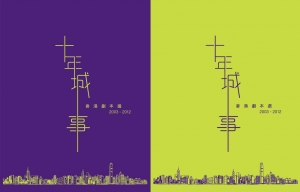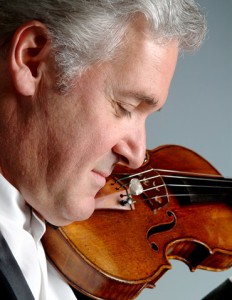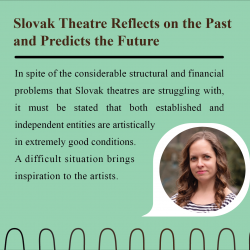2025年7月
The situation in Slovak culture is not very good at the moment. Over the last year, institutions under the Ministry of Culture have undergone a significant consolidation, due to financial restrictions resulting from budgetary savings. There are a total of 30 institutions that are subsidised by the Ministry of Culture: state theatres, museums, galleries, orchestras, libraries, and scientific institutions focusing on research into music, film, theatre, and literature. The hitherto well-functioning system of financial support for culture in general, Slovak Arts Council, has recently undergone enormous changes. Although its budget has been increased by more than 3 million to 30.8 million Euros, the new Council’s management has stopped subsidies to many cultural venues. The Slovak Arts Council finances works for theatre, film, music, literature, arts education, concerts, festivals, amateur arts associations and computer games. The Council’s severe funding constraints have also affected the work of regional and private theatres, but they are all determined to find sources of funding elsewhere and in other ways, convinced that their work is meaningful. The increasingly full auditoriums can testify to this. However, the reduced support will result in one thing, and that is the necessity to increase the ticket price for spectators. The Council’s support has provided sufficient saturation to theatres to make tickets affordable for all. By comparison, tickets for independent theatres are around €12, rarely €20. The Slovak National Theatre has tickets ranging from €25 to €60 (the same range applies for drama, opera and ballet), and the Nova Scena Theatre – the only state musical theatre (subsidised directly by the Ministry of Culture) has the most expensive seats at €43.
Despite the adverse financial as well as political situation, the theatres have come together incredibly over the past year. Several associations have emerged, sharing their current problems and looking for common solutions, with the aim of having a strong voice and thus forcing the Ministry of Culture to listen to them. These are associations that bring together similar organisations in order to identify similar problems: the Association of Slovak Independent Theatres, the Association of Slovak Theatres and Orchestras (representing organisations established by a city, a self-governing region or the state). A new association established in 2024 is the Open Culture! platform. It is a non-partisan, grass-root civic initiative of the cultural community from all over Slovakia. It brings together representatives of institutions established by cities, municipalities and state administration, as well as non-established organisations and independent culture workers. It connects actors from the fields of audiovisual, cultural heritage preservation, visual arts, dance, music, theatre, literature, architecture, design, folklore and other cultural and creative sectors. Its aim is to draw attention to the problems of cultural policy, the lack of professional debate, and undemocratic interference in the functioning of cultural institutions.
In spite of the considerable structural and financial problems that Slovak theatres are struggling with, it must be stated that both established and independent entities are artistically in extremely good conditions. A difficult situation brings inspiration to the artists. The programme of the 20th edition of the theatre festival Dotyky a spojenia (Touches and Connections) bears witness to this. The festival is held annually in Martin, in a small town in the north of Slovakia. Each June, at the end of the season, it brings together 10 most inspiring performances for the local audience, discussions on topics regarding theatre, together with rich accompanying programmes outside of the theatre, workshops and tales for children, street performances and evening concerts on the big stage in front of the theatre, free of charge, for anyone who wants to feel the festival atmosphere. As it is a small town, the local inhabitants value the opportunity to have the best Slovak performances packed in one week. They are proud to host the theatre groups and various theatre experts and critics who visit the festival.
Dotyky a spojenia/Touches and Connections is a showcase of the best productions of the season. This year it turned out that the heart of the Slovak theatre is truly beating at the pace of the present times. As everyone knows, the dramaturgy of the season is prepared in advance. A few months, if not a year before, the theatres must know what they will perform. Not only must the state theatres prepare their titles such a long time ahead – make contracts with the artists, prepare the themes for next seasons. The independent theatres that apply for extra support at the Slovak Arts Council must fill a thorough application describing the future project, its topic, included artists, expected target groups, etc. It means that the theatre premieres are not the result of improvised activity, but are based on a premeditated concept. Themes that concerned the creators at that time may seem outdated when it eventually comes to the opening night. However, it turns out that theatre creators are extremely farsighted in their thinking. It proves the “raison d'être”, the meaning of theatre – it is not only about here and now, even more, it can predict the future.
In the summer of 2024, the news broke that the Minister of Culture had ordered a new national anthem for almost €50,000. The offer was given to a musician (Oskar Rózsa) as a commission, without a public tender in which others could compete. It turned out that in the end it was not a completely new anthem, just a small musical redesign of the original one, which was officially adopted in 1993, when the independent Slovak Republic was established. However, its history dates back to 1844. Regarding the anthem, the project Slovaks Will Come Alive – Anthem for the 21st Century premiered. It was a long-prepared idea by the director of the group Uhol_92, who wanted to research what the new anthem could be, what actually represents us today, what it could be about, and what it should sound like. The director Alžbeta Vrzgula approached three creative teams who put together three micro-situations expressing the feelings and life of a certain generation today.
Vrzgula’s plan was conceived long before the anthem scandal. However, it resonated in this particular way. It was supposed to be a one-off project, but it became a huge success. The three situations directed by three independent creators found a common theme of home, homeland. Young people do not feel such a strong bond towards their homes today. A young director and musician Adam Dragun, who travels freely all over Europe, is tied to home through the land he is about to inherit. A writer, Ivana Gibová, perceives home through the mortgage, the lack of funding for her literary work or through frequent returns to home, where she, as an artist, does not feel welcome. These episodes are linked by a stand-up street musician in a hockey dress who represents national pride. We only feel this when we win at hockey championship, which happened once in the 35 years of the Slovak Republic’s existence.
Some of the last season’s significant performances were strongly connected with ecological topics. It is most prominently represented in the production Mordorys (Andrej Bagar Theatre in Nitra) – nature as an object of threat. The production is based on Olga Tokarczuk’s novel Drive Your Plow Over the Bones of the Dead. It takes place on the Czech-Polish border and the main character is an intellectual who loves nature so much, that she decides to become an avenger for the various hunts committed by members of the town. It is a detective story in which the audience searches for the killer, but is also confronted with the defenselessness of nature and the manipulation of man. The Old Man and the Sea by Hemingway (by Ludus Theatre that prepares performances for so-called young audience) shows nature as an untamed element. The struggle between man and the element is rarely seen today. The productions rather depict nature enslaved by man, threatened, dying. The Old Man and the Sea is a refreshing view of three generations of men. The oldest one is looking for someone to pass on his experience to, struggling with his old age and loneliness at sea. The youngest one (represented by a boy puppet), on the other hand, is looking for a mentor who can dedicate himself to him and teach him about life in a different way than his parents.
The Old Man and the Sea (Photo: Igor Stančík)
A unique theatrical experience, in which the audience got an authentic view of history, was offered by the immersive production Monopol by Kosmopol Theatre. It takes place in the premises of the former Secondary Chemical Industrial School in the Botanical Garden in Banská Štiavnica. The script was based on field research tied to the school, the town and the region and was related to the second half of the 20th century. The audience could simultaneously follow the fates of several families and their intertwining relationships by wandering around the school premises.
The young collective Schwarzes Loch Europas took an original approach to the revision of our past by staging a reconstruction of a real event, namely the first and second sessions of the National Assembly of the Slovak Republic in November 1994, known as the “Slovak Night of the Long Knives”. The audience witnessed a political manipulation aimed at excluding the opposition from any interference in the parliament, depriving it of all powers and securing for itself unlimited power. The actors read the actual transcripts of the meeting, and the characters of the politicians (who are mostly still alive) were merely assumed through costume or a hint of different diction or voice inflection. They were demonstrating them, but they were not pretending. The aim was to convey a live experience of the parliamentary session to the audience, as it was happening in real time, and the spectators became members of the different political parties, even though without the ability to influence the vote.
Gender issues are still strongly present in the Slovak theatre. Women creators are looking (very successfully) for a stronger voice, but direction is still strongly perceived as a male profession. The comedy Status Quo (City Theatre Žilina), written by German playwright Maja Zade, draws attention to everyday gender inequality through the image of a fictional world where male and female roles in society are reversed. It displays men’s problems, such as familiar language in the workplace, inappropriate remarks about appearance, questions about children and family, ambiguous innuendo, or even sexual harassment. We laugh at this funny upside-down world, but also have the opportunity to reflect on our own behaviour towards women.
This year, the view of the position of men in the contemporary world is much more prominent in this discourse. The theme of the radicalisation of young men who cannot find their place in the “new” society resonated particularly in 2024, when a new phenomenon was discussed, namely the widening ideological gap between men and women of Generation Z. While young women tended more towards liberalism, men tended more towards conservative values. The performance Generation Z: Zombies (City Theatre of Pavol Országh Hviezdoslav, Bratislava) responds to this theme and is intended for this target group, but it is also meaningful for the older ones. It is a collective testimony of three young male performers who embark on an intimate exploration of male identity in the 21st century. They confront the commonly held notions of the cave hunter with their own emotionality and vulnerability, which they, as co-authors of the text, demonstrate through their own experiences. Although Hamlet or Sigmund Freud occasionally appear on the scene, the voice of a generation that yearns for redefinition – honest, fragile, but with verve – plays the role. They are looking for a new family background and a place in the job market, and daily encounter centuries-old ideas about the real man, whose position has changed rapidly in recent decades.
Generation Z: Zombies (Photo: Monika Mahútová)
The most successful production of the last year is The Dog on the Road from the Slovak National Theatre. The production is based on a novel by the Slovak author Pavel Vilikovský. It is a non-dramatic text, with only a small plot about a short meeting with a woman. It is a series of thoughts about Slovakia and Slovaks, ironic, but the humour that the author uses is very kind. The main character, the author and writer, is played by four actors at once. They act as a collective hero –
the Slovak, and at the same time represents four ideas that characterise the author: criticism of the nation, eroticism, the search for a soulmate, and dealing with the demons of the past. The director of the production about Slovaks is Germany-based Czech director Dušan David Pařízek, who brought the necessary distance and techniques of German theatre.
The Dog on the Road (Photo: Róbert Tappert)
A special chapter of Slovak theatre is feminist theatre. Director, playwright, and executive director of the Puppet Theatre at the Crossroads, Iveta Škripková, is considered “the mother” of Slovak feminist theatre. As a director herself, Škripková often felt that her position as a creator was looked down upon – even in 2025, this narrative persists in the evaluation of the work of female playwrights and directors. It is as if men had a stronger mandate to lead actors and actresses in the realisation of their creative ideas, just as they have a stronger mandate to govern the country (the number of women in the Slovak parliament is still small, and they are mostly evaluated on their appearance rather than their political stance). Škripková’s personal involvement in the themes of women’s theatre, and also her own emancipation as a female director, led to the founding of the TWIGA studio. It was a pioneering endeavour, and already from the beginning, she had to contend with prejudice: After all, gender equality and emancipation are the norm now, so why make theatre about it? Škripková’s perseverance and determination to devote herself to these topics gradually and slowly shaped the position of “women’s theatre” in Slovakia.
The TWIGA studio (Theatre – Women – Improvisation – Gender – Action) operated at the Puppet Theatre at the Crossroads in Banská Bystrica and on the Slovak puppet and alternative scene for a decade, from 2007 to 2017.
The TWIGA studio used methods of devised theatre and documentary theatre, often drawing on the authentic experiences of actors and actresses, oral history, cross-dressing, cross-voicing, and cross-acting – the deliberate absence of male actors, the portrayal of male characters through cross-dressing or the use of objects and puppets created a new, ironic view of the realities depicted. In addition to depicting everyday situations subject to stereotypes, the TWIGA studio drew attention to gender-correct language and sensitivity to speech in our surroundings that leads us to accept stereotypical and violence-inciting expressions. Given the generational stratification of the ensemble, the themes depicted included perspectives from all sides: The role of the mother was important, but the perspectives of older women were not ignored either. The TWIGA studio essentially conducted research on gender issues, and the results of the research were then portrayed by actresses in a theatrical form. Therefore, collective acting was a frequent theatrical principle: Women performed as collective heroines, creating joint choreographies, from which they were then separated into individualised speeches or dialogues. This generalising theatrical principle, which Iveta Škripková used functionally in her productions, corresponds precisely to the stereotyping that women are subject to, as if they all had the same fate, the same destiny, the same voice, and lived according to the same patterns.
The essence of the TWIGA studio was not just the preparation of specific productions. Many of them were linked to projects, based on long-term research or collaboration, and included various complementary educational events, e.g. after-performance discussions with experts or thematic workshops.
Works portraying gender stereotypes continue in the work of the Puppet Theatre at the Crossroads, although no longer under the umbrella of the TWIGA studio. Through their systematic work against discrimination and for the emancipation and equality of women, actresses and collaborators, led by Iveta Škripková, contributed to raising awareness of gender-based violence, discrimination, and stereotyping. Škripková began her work at a time when the word feminism was considered a “swear word” and her work was viewed with contempt by part of the creative and critical community, who dismissed it as unnecessary and long outdated in the 21st century. However, with each production, Škripková proved that our society still has a long way to go to achieve gender equality and that our stereotypes are deeply rooted. Her honest research, contact with other subjects, and creative approach to topics made her a pioneer of feminist theatre in Slovakia. The latest performance directed by Škripková is about Slovak National Uprising. This event of the summer of 1944 was a historic armed uprising of Slovaks against nazism and fascism. As it was a partisan action of the military and various cooperators, the celebrated heroes are men. But the women in the uprising took part not only as soldiers, but also as essential spies, medics, suppliers, and transporters. Iveta Škripková took four stories of such women and created a performance The Womanly Face of the Uprising. Four stories of women (one was represented by a male actor) depicted the incredible courage and self-sacrifice of women engaged in the Slovak National Uprising. That is a proof that the theatre and its productions still strongly communicate the female experience, but the theme of the war and authentic statements regarding the war have become a part of their artistic expression.
The Womanly Face of the Uprising (Photo: Dodo Šamaj)
Slovak theatre creators are facing a new season. We expect further financial constraints for culture, especially for theatre, that can be critical of all phenomena in our society. However, it turns out that it is in extremely good shape and cannot be stopped just easily.
本網站內一切內容之版權均屬國際演藝評論家協會(香港分會)及原作者所有,未經本會及/或原作者書面同意,不得轉載。
















